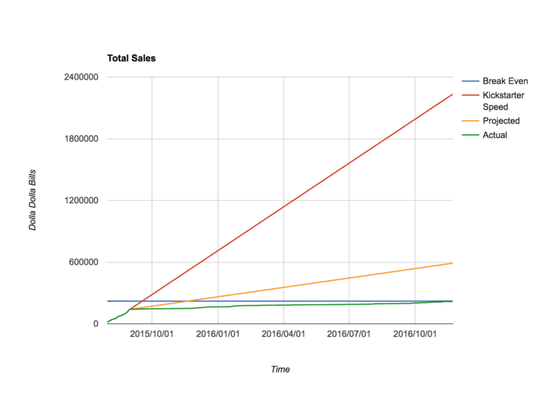Talk that made 4.60 million yen to 16 million yen using Kickstarter of the cloud funding site

ByRex Hammock
On the Kickstarter of the cloud funding site, various products and services are born day by day. A person who has sought investment on such Kickstarter shares his own experience and reveals "Points for making products with Kickstarter".
How we turned $ 140k on Kickstarter into $ 40k in debt. And how we broke even.
https://hackernoon.com/how-we-turned-140k-on-kickstarter-into-40k-in-debt-and-how-we-broke-even-1f86d80fe50f
John Tees Dill, along with his friends Presidential candidate debate game on Kickstarter at the Cloud Funding site "The ContenderWe are looking for a contribution to. The project succeeded and it seems that John ultimately received funds of $ 128,227 (about 15 million yen) from Kickstarter. This may seem like a lot of money from an ordinary person who has never recruited funds in Kickstarter. However, 440 days have actually passed since John started the project on Kickstarter, but it seems that after finally repaying all the debts owed by the project on November 22, 2016, After all it seems that it was zero.
The Contender - thecontender.us

You can tell what kind of game the "The Contender" John's made is by seeing the following movie.
The Contender Rules - YouTube
John, who led the project on Kickstarter, encountered two particularly big problems. One was "where to manufacture" and the other was "how much would it cost to manufacture"?
◆ 1: Where to manufacture
There are two options of manufacturing location, it seems that it was either USA or China. The point of manufacturing in the United States is "to be able to obtain the brand of" Made in America "" to be able to ship quickly than to manufacture in China "" It is also possible to visit the factory, so communication with the manufacturing side It is easy "," It is possible to make corrections quickly if problems arise due to quality etc. " On the other hand, the advantage in manufacturing in China is two, "It can be made 50% cheaper than manufacturing in the USA" "John had previously manufactured games at the factory in China, the factory I had a good relationship with the parties. "
As a result of meeting on the team, The Contender was to be manufactured at a factory in the USA. It seems to be because the reason was simple and we wanted to ship the product by Christmas.
John's team asked the manufacture of The Contender was a company under contract to manufacture table games such as Uno, Katan's pioneer, Magic the Gathering in the United States. Mr. John considers the factory's know-how to be useful for the manufacture of The Contender and has asked the American factory to manufacture it. However, large companies are working with many large companies, and at work they will give priority to such "work with large companies". About such a thing, although a large company can not be said to be a "bad company", John said "We should have asked a vendor who understands the challenge of a small organization like us."
According to these experiences, Mr. John noticed that "Choose a manufacturer with a track record with a company of the same size as your own company".

ByThomas Berg
◆ 2: How much does it cost to manufacture
If you start the project on Kickstarter and make products, there are two points to be careful about in terms of finance, Mr. John. One is "funds that I have to procure to make products," and the other is "funds that I need to procure to start a company." In the case of John, it seems that it cost about $ 150,000 (about 17 million yen) to make a company, and it is clear that this alone required more than the funds collected on Kickstarter .
When the project starts on Kickstarter, The Contender is said to have sold 4000 pieces per month. If this momentum continues, Calculus, it seems that The Contender was able to sell 20 thousand pieces by the time the election is over, but if you order an order of 20 thousand pieces, John will get $ 40,000 4.6 million yen) will be borne on the back. However, if we were able to sell all the 20,000 orders we ordered, John was able to make a profit of 150,000 dollars.
The graph below shows time on the horizontal axis and total sales of The Contender on the vertical axis. As you can see, as you can see, although we are selling gradually, we can see that as soon as the project on Kickstarter is over, its sales are sluggish.

In the graphs below, the horizontal axis shows time, the vertical axis shows the total sales of The Contender, the red line shows changes in sales figures when assuming that sales will grow with momentum as Kickstarter announces the project, yellow The line actually shows changes in sales figures predicted by John, the green line shows actual change in sales figures, and the blue line shows breakeven point where sales and expense amounts are exactly equal.

From this, John says, "If you are thinking about selling products even after the Kickstarter project is over, you should at the most about double the number sold on Kickstarter."
In addition, Mr. John cites "the place to keep inventory" and "how to sell products after Kickstarter" as the problems they encountered. It seems that John actually issued advertisements several times on Facebook, YouTube, etc., but they seem to have rarely contributed to sales actually. Instead, when Contributing articles on news sites and so on in line with party party rallies and primary elections held in Iowa, the sales of The Contender seems to have increased significantly.
Related Posts:
in Note, Posted by logu_ii







